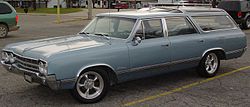| Revision as of 15:43, 13 March 2007 edit70.229.197.120 (talk)No edit summary← Previous edit | Revision as of 16:16, 13 March 2007 edit undo69.105.238.79 (talk) rvv ←Undid revision 114817187 by 70.229.197.120 (talk)Next edit → | ||
| Line 48: | Line 48: | ||
| Although the roof glass was substituted for an optional pop-up front-row sunroof for the 1973 model year, the Vista Cruiser name continued for five more model years as an elevated trim level of the Cutlass Supreme station wagon until the Cutlass Cruiser was introduced for the 1978 model year. | Although the roof glass was substituted for an optional pop-up front-row sunroof for the 1973 model year, the Vista Cruiser name continued for five more model years as an elevated trim level of the Cutlass Supreme station wagon until the Cutlass Cruiser was introduced for the 1978 model year. | ||
| Dave Fesz is the current owner of the most sought after 1970 Vista Cruiser in existence. | |||
Revision as of 16:16, 13 March 2007
Motor vehicle
| ||||||||||||||||||||||
Motor vehicle
| ||||||||||||||||||||||
Motor vehicle
| ||||||||||||||||||||||
Motor vehicle
| ||||||||||||||||||||||
The Vista Cruiser was a station wagon built by the Oldsmobile Division of General Motors from 1964 to 1977, which was based on the Oldsmobile Cutlass/F-85 model, but had a slightly longer wheelbase than the cars it was based upon.
Noted for the glass found in the roof over the second-row seating and for the smaller glass panels over the rear cargo area windows, this car was introduced to the public on February 4, 1964 as a 1964 model. This body style with the split front skylight continued through the 1967 model year and was replaced by a radically redesigned model for 1968 that featured a one-piece front skylight. This body style was not unique to Oldsmobile, being shared with the Buick Sport Wagon, and was not repeated in future Oldsmobile mid-size wagons, however, the skylight concept was repeated with the 1991-92 full-size Oldsmobile Custom Cruiser wagon and echoed by its corporate sibling, the 1991-96 Buick Roadmaster wagon. The forward facing third row seat is also unusual for car-based wagons, and is also seen on the Ford Freestyle and Eagle Medallion.
This design also featured an elevated rear roof section, based on the Budd Company Vista Dome, and the GM SceniCruiser bus made for Greyhound Lines in the 1950s, and also allowed extra headroom for an optional front-facing third-row seat.
Although the roof glass was substituted for an optional pop-up front-row sunroof for the 1973 model year, the Vista Cruiser name continued for five more model years as an elevated trim level of the Cutlass Supreme station wagon until the Cutlass Cruiser was introduced for the 1978 model year.
Pop Culture
A second generation 1969 Vista Cruiser was Eric Forman's car on That '70s Show.
At the beginning of National Lampoon's Vacation the car that gets crushed is a Vista Cruiser.
External links
| Oldsmobile vehicles | ||||||||||||||||||||||
|---|---|---|---|---|---|---|---|---|---|---|---|---|---|---|---|---|---|---|---|---|---|---|
| A division of General Motors, 1908–2004 | ||||||||||||||||||||||
| Production models (by year of introduction) |
|  | ||||||||||||||||||||
| Concept models | ||||||||||||||||||||||
| Related brands | ||||||||||||||||||||||


